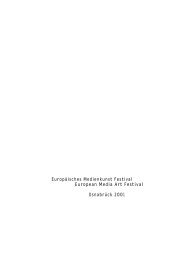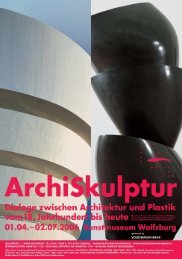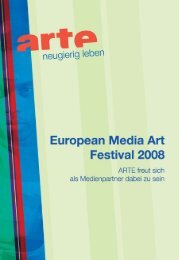EUROPEAN MEDIA ART FESTIVAL OSNABRUECK 2011 - Emaf
EUROPEAN MEDIA ART FESTIVAL OSNABRUECK 2011 - Emaf
EUROPEAN MEDIA ART FESTIVAL OSNABRUECK 2011 - Emaf
Create successful ePaper yourself
Turn your PDF publications into a flip-book with our unique Google optimized e-Paper software.
Lawder gave his parents a list of equipment from Sears that he wanted for his birthday - trays, chemicals, a safe<br />
light - and he took over a closet in the house for his darkroom. ›I remember my first print. It was a photograph<br />
of Mom with our horse Little Man. It was very grainy, black-and-white, underexposed. But that's where it started.‹<br />
Where Lawder really made his mark in the art world was with 16mm films, which he got into shooting while in<br />
graduate school at Yale. Today, several of his films are in the Museum of Modern Art's permanent collection. Of<br />
these films he says, ›I don't script, write story boards, or conceive them full blown. I find a piece of film and wonder<br />
what direction it wants to go in.‹<br />
As the case with the film ›Necrology‹ (roll call of the dead). Shot in Grand Central Station, Lawder captured 12<br />
minutes of anonymous commuters in their daily routines. Back in his studio, because he was too tired to rewind<br />
the film, he simply watched it backwards and the concept was born. The effect of the finished film eerily shows<br />
lines of people ascending and disappearing into a shadowy abyss. Lawder added a lengthy list of bogus credits<br />
to the end for a touch of rather morbid humor that leaves viewers to ponder their own fate. ›Once I shot the<br />
escalator, I thought, what was interesting about it? What are we looking at? What do we think we're looking at?<br />
What the hell is going on? I'm interested in questions like that.‹<br />
But as much as he loves film, Lawder doesn't teach it at the Denver Darkroom. He says it would be like teaching<br />
an introduction to surgery course - it's just too complicated. ›You can't make films like Necrology anymore.<br />
It was a throw away idea. That film cost me $ 182 to make in 1969. You could do that then: roll film, check out<br />
an idea, and chase it,‹ he says. ›Today the cost is prohibitive. It's a dinosaur technology. The parade's gone by.‹<br />
When asked why he doesn't shoot in digital format, Lawder says, slightly appalled, ›You're not making a film.<br />
You're making a video. I like the projected image. I like the impact. You're sitting in a dark room bonded by everybody's<br />
attention to this glowing rectangle on the screen. There's nothing else to look at. You make a pact with<br />
it. You either sit it out or get up and leave. Video never interested me. It's illuminated furniture. Most of my films<br />
could not have been made on video. Theoretically, maybe, yes. But they would not have evolved.‹<br />
Bio<br />
Standish D. Lawder is an artist whose subtle sense of humor delights in circumventing the more traditional notions<br />
of audio visual media and catching his audience unaware. Born in New York City in 1936, Lawder received<br />
his BA from Williams College in 1958, and his Ph.D. from Yale University 1967 for writing what is believed to be<br />
the first doctorate ever awarded in art history on the subject of film. His dissertation examined the way various<br />
art historical ›isms‹ - i.e., cubism, surrealism, dadaism, German expressionism, Soviet constructivism - are<br />
manifested in certain films. His book, ›The Cubist Cinema‹, published by the New York University Press in 1975,<br />
has been translated into several languages. The same year his work was included in ›A History of the American<br />
Avant-Garde Cinema‹, a traveling film exhibition organized by the American Federation of Arts.<br />
Standish Lawder has been making films, which range from the comic to the sublime (and are often both at once)<br />
and other visual presentations for 30 years and he taught visual arts at Yale, Harvard and the University of California<br />
at San Diego. He now lives in Denver, where he is running the Denver Darkroom he founded in 1996. The<br />
Denver Darkroom is a non-profit teaching center for fine art photography. With classes and workshops ranging<br />
from Digital Photo 101 to highly specialized workshops, Standish provides instruction in every level of photography<br />
and every aspect of photographic art.<br />
119












